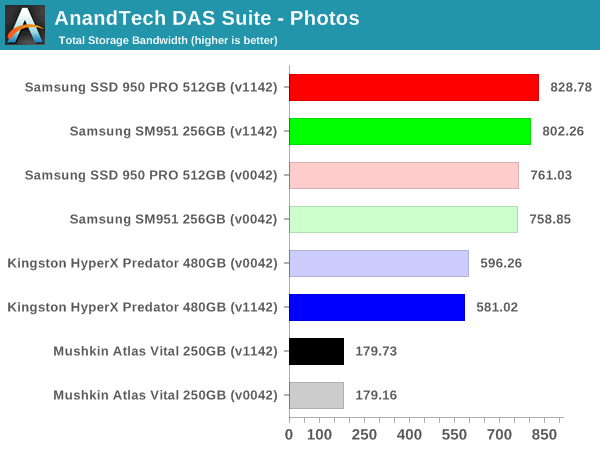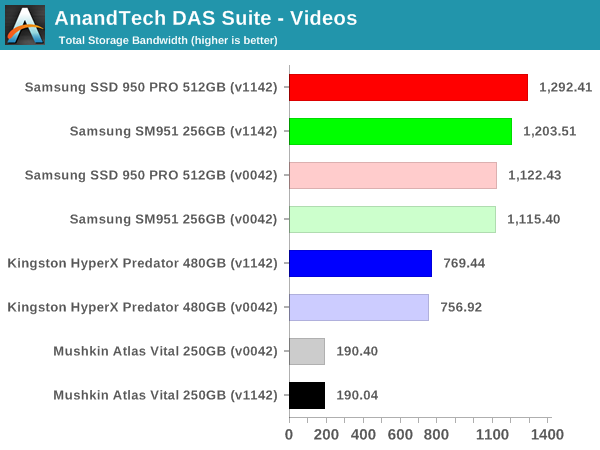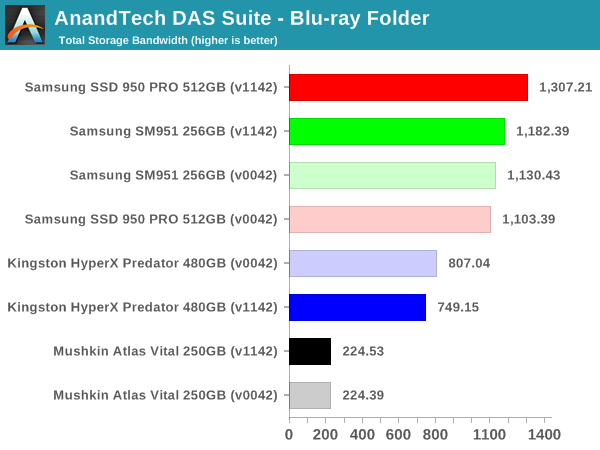Choosing the Right SSD for a Skylake-U System
by Ganesh T S on May 9, 2016 8:00 AM ESTAnandTech DAS Suite - Power Consumption and Thermal Characteristics
SYSmark 2014 and PCMark 8 provide a high-level view of how the storage device might affect the overall responsiveness of the system. However, when evaluating different SSDs for use in the same system, there are other factors like power consumption and thermal characteristics. In addition, one of the scenarios not considered by either SYSmark 2014 or PCMark 8 is the transfer of large amounts of data (say, a bunch of photos or videos) from a mass storage device to the primary drive in the system. AnandTech's DAS (Direct-Attached Storage) Test Suite covers all these aspects.
The Intel NUC6i5SYK doesn't have a USB 3.1 Gen 2 or Thunderbolt port. Hence, it is difficult, if not, impossible, for an external storage device to keep up with the performance of the PCIe drives inside the system. Therefore, we modified our DAS suite to do the transfer from the primary 120GB partition to the secondary partition of the SSD under test. No RAM drive was set up. The bandwidth and temperature tracking were retained. The test can also reveal whether thermal throttling is triggered due to the transfer of large amounts of data (around 250GB) within a small time window. Before looking at the performance consistency / temperature / bandwidth graphs, let us take a look at the total instantaneous bandwidth numbers for the three different test cases in the DAS test suite.



In terms of raw bandwidth and the time taken to finish copying large amounts of data between partitions, the PCIe 3.0 x4 NVMe SSDs obviously win big. However, one must also consider how common this use-case is going to be (given that most external storage devices for Skylake-U systems are not going to keep up with PCIe 2.0 x4 AHCI drives, let alone going to PCIe 3.0 x4 NVMe drives).
The graphs below show the temperature and instantaneous bandwidth numbers for different SSDs with the two BIOS versions. Below that, we also have the power consumed at the wall by the NUC while processing the test suite.
| AnandTech DAS Suite Instantaneous Bandwidth, Thermal Characteristics and At-Wall Power Consumption |
|||
| Mushkin Atlas Vital 250GB MKNSSDAV250GB D8 | Samsung SM951 256GB MZVPV256 | Samsung SSD 950 PRO 512GB | Kingston HyperX Predator 480GB SHPM2280P2H 480G |
-Performance-Consistency.png) |
|||
-Power.png) |
|||
| Mushkin Atlas Vital 250GB MKNSSDAV250GB D8 | Samsung SM951 256GB MZVPV256 | Samsung SSD 950 PRO 512GB | Kingston HyperX Predator 480GB SHPM2280P2H 480G |
The interesting graph to note here is that of the Kingston HyperX Predator SSD. Within a short time after the benchmarking script completes, the drive starts doing power-intensive data shuffling using the huge 1GB DRAM cache on the SSD. We did confirm that the consistently high power draw during the process was not related to any CPU activity. It can also be seen that this background activity in the HyperX Predator is dependent on a number of factors, and the behavior is not always consistent (with the older BIOS, the activity took place without any breaks, but, with the newer BIOS, there were two regions of idling inbetween).
| Intel NUC6i5SYK - Idle Power Consumption | ||||
| Samsung SM951 | Samsung SSD 950 PRO | Kingston HyperX Predator | Mushkin Atlas Vital | |
| OPI GT2 (BIOS v0042) |
7.86 W | 8.46 W | 10.77 W | 7.62 W |
| OPI GT4 (BIOS v1142) |
8.18 W | 10.15 W | 10.78 W | 8.25 W |
Coming back to the quantitative aspects, the tables on either side show the power numbers for the two different link rates (they are slightly different from the numbers in the graphs above, because they only consider the time taken for the test suite to complete, and don't take into account the eventual data shifting done by the controller during idle periods). It can be seen that OPI GT2 is a little bit more power efficient compared to OPI GT4 for the same hardware configuration. The load numbers are a bit different, though, with there being no clear winner across all tested SSDs.
| Intel NUC6i5SYK - Load Power Consumption (AnandTech DAS Suite) | ||||
| Samsung SM951 | Samsung SSD 950 PRO | Kingston HyperX Predator | Mushkin Atlas Vital | |
| OPI GT2 (BIOS v0042) |
22.49 W | 22.49 W | 20.06 W | 17.53 W |
| OPI GT4 (BIOS v1142) |
22.09 W | 22.14 W | 21.24 W | 16.08 W |
The Mushkin Atlas Vital is the most power efficient of the lot (both at load and idle). Even though the Mushkin SSD consumes a lot more energy for the tested task compared to the other SSDs, its idle power is also the lowest. For a desktop running 24x7, it is bound to come out as the better choice for users building a low power computer. The Kingston SSD idles a bit higher compared to the Samsung SSDs, but the load power is lower thanks to the lower transfer rates sustained by former. The number of flash packages and the presence of DRAM in the SSD also influences the power consumption numbers in the above tables. Temperature-wise, all the SSDs ended up between 56 and 59C after the test suite finished processing.










40 Comments
View All Comments
BPB - Monday, May 9, 2016 - link
"We also managed to check out four different SSDs for usage in Skylake-U systems in general (and the NUC6i5SYK in particular)."The new NUCs are not capable of using the 950 Pro at full speed. Yes, the specs look like they do, but they don't. The maximum speed supported is 1600MB/s. Page 45 of this doc has the specs:
http://www.intel.com/content/dam/support/us/en/doc...
You can also view a discussion at the Intel Community regarding this:
https://communities.intel.com/message/372201#37220...
This being the case, which SSD makes the best buy?
ganeshts - Monday, May 9, 2016 - link
Please go through the article at least once before commenting. Did you look at the CrystalDiskMark benchmark numbers with the NEW DEVELOPMENT BIOS? Intel has resolved this issue, and the whole point of this review was going into the reasons behind this.BPB - Monday, May 9, 2016 - link
Sorry, read while at work and only had time to breeze through. I looked for those numbers but didn't see them. Wish I could delete my post...willis936 - Monday, May 9, 2016 - link
Does this apply to all -U processors? I think far more interesting than NUCs are people with broadwell and skylake -U laptops.ganeshts - Monday, May 9, 2016 - link
This is applicable to all Skylake-U processors.Yes, notebooks are an interesting category that we have tried to cover in this article, but, without numbers to back up. Our impression is that the lower idle power needed for notebooks might make vendors go with the GT2 OPI setting. So, the numbers are likely to be closer to the BIOS v0042 results that we saw in this review. So, yes, it is likely that PCIe 3.0 x4 SSDs can't get full performance with Skylake-U laptops. Of course, vendors have the knob to turn on the higher performance / higher idle power setting, if they want.
rish95 - Tuesday, May 10, 2016 - link
You guys wouldn't happen to have power consumption numbers on the PM951, would you?It appears the Surface Book's drive is replaceable following a tedious opening procedure, and I've been thinking of replacing the 128 GB PM951 that came with mine with a larger 950 Pro or its successor. The 128 PM drive has terrible slow write performance due to the lack of TurboWrite.
However, I am concerned that the extra performance the 950 and SM series SSDs offer comes at a huge power penalty, and I certainly wouldn't want to give up the fantastic battery life this device offers.
ez76 - Monday, May 9, 2016 - link
How can I tell if my Skylake-U system has an OPT GT2 or OPT GT4 configuration?ganeshts - Monday, May 9, 2016 - link
Easiest way is to ask the manufacturer. Otherwise, if the system has a M.2 PCIe x4 slot for a SSD, benchmark something like the SSD 950 PRO using CrystalDiskMark.Hopefully, after Intel makes this BIOS public, more vendors will put out BIOS updates and spell the OPI link rate out in the change log.
Junkmail1 - Monday, May 9, 2016 - link
I went through the article twice and the comments once. Now I'm second guessing that choice!buyme50 - Saturday, May 14, 2016 - link
"However, the warranty aspect is a bit worrisome, since the SM951 is an OEM model."Thank you for mentioning this. I had an SM951 die recently. Newegg's third party seller would not honor the warranty posted (3 years), Newegg would not do anything, and Samsung refused to warranty it. Don't buy the SM951 unless you don't want a warranty and want to risk losing your data.